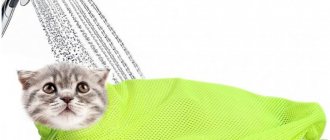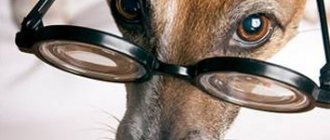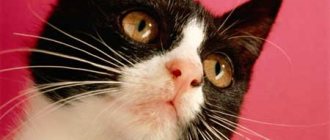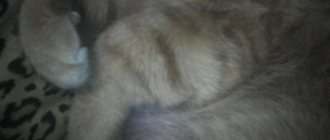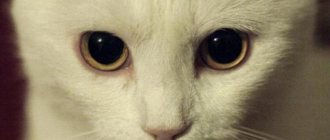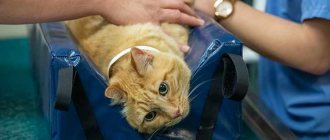An important indicator that can signal serious troubles associated with a cat’s health is the darkening of the color of its urine. Having barely noticed this problem, the owner must immediately contact a veterinarian to receive qualified help. At the same time, it is necessary to control not only the color of urine, but also the smell and transparency. These indicators can become symptoms of a large number of serious diseases associated with the liver, urinary tract diseases or dehydration. Why do cats have dark urine, and what should the owner do to protect the animal from unpleasant consequences? The answers are further in the article.
Normal urine color in a healthy cat
To make sure that the urine has darkened or acquired an uncharacteristic shade, it is collected in a clean transparent container and placed in front of a white sheet of paper. If the pet is not used to going to the litter box without filler, then put a piece of light-colored fabric without a pattern and then evaluate whether the cat’s urine is really brown.
A healthy animal's urine is straw, amber, or light yellow in color. A pathology is considered to be either urine that is bright or dark in color, or urine that is too light, almost transparent.
Before suspecting a serious illness, it is useful to remember whether your pet has eaten something delicacy or unusual for it. Or maybe he's taking medication. Some antibiotics, antitumor drugs, and anti-cystitis medications cause urine to turn orange. If so, then you should wait until the end of the course of treatment and again pay attention to the shade. It is likely that the excrement will return to its original color.
Leukocytes, units/μl: normal - negative.
Leukocyturia, especially weakly or moderately expressed, does not always (primarily in cats) indicate an infectious disease of the urinary system, although it is the most common reason for the unjustified prescription of antibiotic therapy. Most chronic GN and CKD are characterized by intense focal and/or diffuse infiltration of the renal parenchyma by agranulocytes, which are involved either in autoimmune inflammation or in the processes of destruction of sclerotic areas of the parenchyma. On the other hand, infectious (septic) leukocyturia is a characteristic sign of acute pyelonephritis. However, during remission or during a latent course of chronic pyelonephritis, it may be absent. Therefore, in most cases, an infectious disease of the urinary system is recognized only if a urine sample correctly obtained by transperitoneal urocystocyntesis during bacteriological examination reveals a microflora that is pathogenic and not saprophytic for the skin or gastrointestinal tract. However, when assessing negative results of bacterial culture (urine is sterile), one should take into account the intermittent (variable) nature of bacteriuria in chronic pyelonephritis (this is not observed in pyonephrosis), as well as difficulties in identifying certain forms of pathogenic bacteria.
How to determine color?
This confuses many owners. Indeed, if a pet relieves itself in the garden, then the task is almost impossible. But if you see that your pet has become boring, then you need to try to keep an eye on him. It's not that difficult. If the animal is really sick, it will not go far. Surely the cat will empty its bladder near the nearest post and return home. It is much easier if the animal is trained to relieve itself in the tray. Then leave it empty once, without filler, and evaluate the collected material.
What will you need to pay attention to? The urine of a healthy cat is yellowish, but not rich in color. Urobilin gives urine its straw color. It is removed from the body in this way so as not to affect the animal’s nervous system. Dark urine in a cat, or bright yellow, rich urine, indicates health problems.
By the way, completely transparent urine is also bad. In this case, we can assume that the animal drank a lot of water, which is why the color turned out so diluted. Then you need to repeat the collection a little later. But the absence of a characteristic color of urine may indicate pathologies of the endocrine glands, diseases of the adrenal glands, or diabetes mellitus.
Normal and pathological color
The straw-yellow, amber, yellowish color of urine in a healthy cat is due to the presence of a bilirubin derivative, urobilin. A change in the color of urine, as a rule, indicates a problem in the pet’s body. At the same time, the development of pathology is indicated by both too light and too dark urine.
Light, watery urine is observed with polydipsia (increased thirst in an animal). An increase in water consumption leads to the fact that the body does not have time to saturate the urine with urobilin, and it becomes almost colorless, with a slightly yellowish tint. This phenomenon can be observed in diabetes mellitus and hypothyroidism.
A deep yellow color to your pet's urine may indicate dehydration. Feeding a cat with dry concentrated food without free access to water often results in the urine turning an intense yellow color. Taking medications often causes changes in the color of urine. In this case, lemon or deep yellow color should not cause concern to the owner.
The color of urine depending on the health status of the pet
The dark yellow color is due to an increase in the concentration of pigments (dyes) in the urine. This is caused by impaired drinking, vomiting, and diarrhea.
Sometimes the color can be greenish-brown, reminiscent of beer. Such a change indicates the presence of a purulent infection and is observed with pyelonephritis, inflammation of the bladder, etc.
The red color of urine indicates the presence of fresh blood and often accompanies injuries to the bladder and kidneys, renal infarction, and renal colic. The color of meat slops is observed due to the presence of altered blood in the urine due to glomerulonephritis.
Physical indicators
Physical indicators are studied using organoleptics - a research method based on the perception of the senses: visual, olfactory and tactile. The only exception is pH, or acidity. It is calculated based on the specific gravity of urine.
Volume allocated per day
Norm
: 7-15 ml per 1 kg of weight.
Promotion
: may mean chronic renal failure, metabolic disorders, kidney infections, diabetes, inflammation, the presence of neoplasms, hypercalcemia, disappearance of edema.
Demotion
: may mean acute renal failure, increased edema, shock, gastrointestinal disorders (diarrhea, nausea), insufficient water intake.
The volume released per day directly depends on the liquid drunk per day. It accounts for 70% of urine. The exact amount is determined in the hospital, since at home the filler poured into the tray gets in the way.
Color
Norm
: yellow and light yellow.
Darkening of the shade is typical for diarrhea, vomiting, burns, liver diseases, poisoning, urolithiasis, hemolytic anemia, melanosarcoma, hemoglobinuria, pyelonephritis, urocystitis, glomerulonephritis.
Lightening of the shade is typical for diabetes mellitus, impaired concentration function of the kidneys, prolonged use of medications and some vegetables (beets, carrots).
Chromaticity is denoted as COL. It directly depends on the type of feeding and daily water consumption. The more a cat drinks, the lighter its urine.
Brief discoloration due to certain foods and medications is acceptable. Pathology is discussed only when the deviation persists for more than 2 days. Depending on the disease, the yellow tint changes to scarlet, green, beer and completely black.
Consistency
Norm
: liquid.
Thickening to a mushy and jelly-like form indicates purulent processes and urolithiasis. Also, inclusions of mucus are characteristic of cystitis and inflammatory processes in the urinary tract.
To determine this parameter, temporarily remove the litter and wait until the pet goes to the toilet. Slowly pour the biomaterial from the tray into any container. If the animal is healthy, then the consistency of its liquid feces should resemble ordinary water.
Clarity and sediment
Norm
: complete transparency with a small sediment of epithelium, microorganisms, salts, crystals.
Severe clouding occurs with urolithiasis, malignant neoplasms, prostatitis, inflammation of the kidney tissue, bladder and ureters.
Transparency is designated as CLA. If you take a glass of urine from a healthy animal, you can easily read the printed text through it. The exact cause of the clouding will be determined with the help of additional tests. Sometimes the deviation is due to improper transportation.
Smell
Norm
: specific, unsharp.
Changes in odor are rare. A strong stench occurs during prolonged stagnation, characteristic of blockage of the urinary tract. If the smell resembles rot or feces, then the cause of the changes lies in cystitis or paraproctitis (rectal fistula).
Specific gravity (density)
Norm
: 1.015-1.030 (has no units of measurement, as it is a relative value).
Promotion
: may mean dehydration, increased edema (acute glomerulonephritis), toxicosis, acute nephritis.
Demotion
: may mean diabetes insipidus, heavy drinking, chronic renal failure and acute tubular damage, infusion therapy, nephrosclerosis.
Specific gravity is denoted as USG. It evaluates the work of the kidneys by dissolving solid compounds in urine, that is, its concentration. The density changes several times a day, so it is recommended to check several samples at once. An increased concentration is typical for the morning collection of biomaterial after a long sleep.
Acid reaction
Norm
: 6.0-7.0 mol/l.
Promotion
: may mean hypokalemia, metabolic disorders (alkalosis), bacterial infection, chronic renal failure, oncology of the genitourinary system.
Demotion
: May indicate renal failure, diabetic coma, nephritis.
Acidity is referred to as pH. In addition to the disease, the type of diet affects the deviations. An excess of animal proteins leads to oxidation and lowers acidity, and an excess of plant foods leads to alkalization and an increase in pH. Long-term deviation is fraught with the appearance of urates - urinary stones that cause urolithiasis.
Diagnosis of diseases
Before contacting the veterinary clinic, the animal should be kept on a fasting diet for 8-12 hours. At the same time, he retains free access to drinking water. The doctor will definitely prescribe not only a urine test, but also a general and biochemical blood test, which is taken on an empty stomach. The absence of food in the stomach and intestines will facilitate an ultrasound examination of the kidneys and bladder. In order not to prolong the diagnosis, you can prepare and collect urine in advance. Pet stores sell special filler that does not absorb liquid. Using a sterile syringe, 30-50 ml of urine is drawn into a special container and delivered to the laboratory within 3 hours. At the first stage, these examinations are enough to determine the amount of drug therapy and the need for surgical intervention.
What does dark color indicate?
If, when cleaning the litter box, it is discovered that the cat’s urine is dark in color, then this phenomenon is a serious cause for alarm. A change in the color of urine towards the dark side is observed in a number of pathologies and can be a symptom of the development of a serious illness in the pet.
| Reasons for dark colored urine | Brief description of the pathology |
| Urolithiasis disease | The most common cause of darkening the color of urine in cats. Urea crystals themselves damage the mucous membrane of the urinary organs. The formation of struvite (stones) in the kidneys and bladder leads to injuries and microbleeding, which is observed in the form of dark-colored urine. Males are most often affected by pathology. If, during inspection of the litter box, the owner notices that the neutered cat has dark urine, the pet should immediately be tested to rule out urolithiasis in the pet. |
| Inflammatory and infectious processes in the genitourinary area | Bacteria and viruses often complicate the course of inflammation in cystitis and urethritis. Often the reason why urine is dark in color is pyelonephritis - a dangerous purulent inflammation in the kidneys. Under the influence of infection, the acidity of urine changes, the permeability of blood vessels increases, which is accompanied by darkening of the urine. Bloody discharge can also occur with such severe diseases of the reproductive system as ovarian cancer, malignant neoplasms in the uterus |
| Infectious and parasitic diseases | Dark color of urine is observed with a dangerous disease for humans and animals - leptospirosis. Microscopic pathogens lead to general intoxication of the body. The urine of a sick cat darkens, sometimes acquiring a brick tint. The dark color of cat urine is also characteristic of many blood-parasitic diseases, for example, piroplasmosis |
| Blood diseases | If the clotting process is disrupted, when platelets are not produced enough, the cat develops a pathological condition - thrombocytopenia. Pathology accompanies diseases such as hepatitis, autoimmune disorders, poisoning, infections |
In addition to serious reasons leading to changes in the organoleptic parameters of feces, a pet may also have physiological ones. For example, in some cats, when estrus occurs, the urine acquires a darker shade, which is not a pathology.
Dark urine in a cat: treatment
If a cat has dark urine, the physiological state of the pet should be analyzed. During estrus, vocal symptoms come to the fore. If a pathological sign appears in a cat, you need to consult a doctor; boys are more susceptible to urolithiasis than girls.
You should not use medications yourself. You can do harm, or, at best, mask the symptoms of a real disease. The veterinarian prescribes treatment, and the pet owner ensures that the pet takes pills or medicated food.
Treatment of diseases: options and approaches
Depending on the illness that caused the change in the color of the urine, the fluffy is prescribed a set of medications. If a pathology is diagnosed, the veterinarian will prescribe the pet a strict diet and drinking regime. To treat inflammatory processes in the kidneys, antispasmodics and uroseptics are prescribed. With urolithiasis, there is a possibility of surgery to remove the stone from the urinary tract if it is too large. Infectious diseases are treated with antibiotics, and parasitic infestations and blood diseases can be treated with specific medications.
It is important to remember that self-medication is dangerous, and seeking specialized help as soon as possible increases the likelihood of your pet’s recovery.
Treatment
If the cat’s urine is dark brown, and the diagnosis shows the presence of one of the diseases listed above, then the doctor will select an individual treatment regimen. Depending on the condition of the furry patient, the following may be prescribed:
- Antispasmodics and painkillers.
- Immunomodulators.
- Antibiotics that help fight infections.
- Restorative droppers.
- In some cases, surgical intervention is not possible. Then the doctor will prepare your pet for surgery.
Be sure to control the amount of water you drink. Sometimes special foods are prescribed that provoke thirst. If your pet continues to refuse, then try to stimulate him in every way. Install a decorative fountain and a small aquarium with artificial fish.
Symptomatic treatment
In order to properly treat the animal, you need to determine the diagnosis, which means you need to take the pet to the clinic. Many of the diseases that lead to discoloration of urine are serious and require special knowledge to help the animal. Some diseases, if left untreated, can lead to the death of a pet.
To understand the reason for the change in urine color, a specialist will prescribe tests and conduct an ultrasound examination.
Once the diagnosis is established, the veterinarian will prescribe treatment. Most often used:
- antispasmodics;
- anti-inflammatory drugs;
- anthelmintic drugs;
- enzymes and hepatoprotectors;
- antibiotics to remove infectious agents;
- drugs to restore normal intestinal microflora;
- painkillers if the animal is in pain;
- the veterinarian can insert a catheter and flush the bladder;
- herbal remedies, homeopathy to dissolve uric acid salts;
- surgical intervention in the presence of stones or tumors in the kidneys and bladder;
- sterilization and surgery on the genital organs in case of pathologies;
- a strict diet, which in case of irreversible conditions will have to be followed for life.
Options for helping an animal
If your cat's urine becomes dark, the causes and treatment of the symptom should be determined and prescribed by a veterinarian.
You should follow the drinking regime, avoiding dehydration when feeding dry food. If urolithiasis is detected, a strict diet is prescribed, fish and raw meat are excluded. Medicinal treatment includes antispasmodics, painkillers, and drugs that dissolve uric acid crystals. According to indications, surgical removal of stones can be performed.
For inflammatory infections, antibacterial agents and immunomodulators are used. Parasitic diseases require the use of specific agents. Liver diseases that lead to darkening of the color of urine are treated with hepatoprotectors and enzymes.
Dark colored urine in your pet is rarely a harmless symptom. Most often, this indicates the development of some pathology in the internal organs or the genitourinary system. Only a veterinarian can make an accurate diagnosis and prescribe adequate treatment.
Prevention measures
Even with vigilant monitoring of your pet's health, he can get sick. The reasons lie not only in lifestyle and diet, but also in genetic damage, autoimmune diseases, injuries, from which it may be impossible to prevent a cat. It is up to pet owners to provide healthy nutrition and care. And if your pet has become lethargic, apathetic and refuses treats, you should show him to the veterinarian as soon as possible, without waiting for more serious manifestations of the disease.
A change in the color of urine indicates a variety of pathological conditions. If this is the only sign that alerts the owner, then simply observing the pet for 2-3 days is enough. However, if the pet is weakened or has any other symptoms, then seeking specialized help should be done as soon as possible. What you definitely shouldn’t do is compare symptoms using available articles and self-medicate.
What should urine normally be like in a kitten and an adult animal: color, consistency
In healthy animals, urine is yellow or light yellow, which is due to the content of the bile pigment urobilin, which is formed during the oxidation of urobilinogen. Its transparency must be absolute, it must not contain foreign inclusions. Cloudy fluid indicates kidney problems. As for sediment formed by insoluble salts, crystals, epithelial cells, organic compounds and microorganisms, only a small amount is allowed. Normally, cat urine has a liquid consistency.
Changes in the type of urine and urination pattern in a cat
Anastasia Mikhailovna Polozova, general practitioner
It is the owner’s duty not only to feed and caress his pet, but also to monitor the slightest changes in his health. The process of urination, its frequency, volume and appearance of urine does not escape the eyes of an attentive owner.
The parameters of urination and the properties of urine, which we can evaluate with the naked eye and determine using the sense of smell, are called the physical properties of urine. The study of this group of properties is an integral part of a general clinical urine analysis - one of the important diagnostic tools of a veterinarian. A general clinical examination of urine can provide a lot of diagnostic information about the functioning of the organs of the urinary system and the general condition of the body. With the help of this study, it is possible to dynamically track changes in the course of many diseases and evaluate the response to treatment. An important condition is the correct collection of urine for analysis.
The first thing it is important for a cat owner to pay attention to is the pattern of urination. Let us dwell on this section in more detail, since the doctor cannot obtain this information on his own at the first appointment (unlike assessing the appearance of the urine itself if you bring it with you), he can only draw the appropriate conclusions from your words.
Changes in the frequency of urination and the amount of urine can be an important symptom indicating the disease. They are expressed in an increase in the amount of urine (polyuria), a decrease (oliguria), or absence (anuria) of urine. And it is important not to confuse polyuria with urinary incontinence or frequent urination (pollakiuria), and oliguria and anuria with stranguria - difficult, frequent and painful urination. All this data can be obtained by direct observation of the animal during urination.
An increase in the amount of urine (polyuria) can occur with increased thirst (polydipsia), such animals feel a frequent urge to urinate and produce more urine per day. Very often, these two symptoms are associated with each other and appear with purulent inflammation of the uterus and other intoxications, diabetes, and renal failure.
A decrease in diuresis (oliguria) occurs with insufficient fluid intake, diseases accompanied by an increase in body temperature, vomiting, diarrhea and other pathologies. A sharp decrease in diuresis, up to a complete cessation of urine output (anuria), is observed in diseases that cause acute renal failure (kidney disease, urolithiasis, heart failure, DIC, poisoning, etc.).
Normal cat urination frequency
Cats evolved from the dry, arid regions of Mesopotamia. Water was scarce, so they developed ingenious systems to maintain hydration. As a result, most healthy, adult indoor cats will urinate on average twice a day. How often your cat goes to the toilet will depend on water consumption, heat and humidity, the amount of moisture in the food, as well as medical conditions such as the presence or absence of kidney disease, bladder infections, liver problems, hormonal imbalances and so on.
It is important to know your cat's normal daily urination and bowel habits. Some cats are fine with urinating five times a day, while for others this will signal a sharp increase in potty trips. Many cats only use litter box once or twice a day, and using it four times a day will signal a problem. If your cat suddenly begins to urinate more or less than usual, don't ignore it or put off visiting your veterinarian. Any changes in urination frequency should be checked immediately by your veterinarian.
Postoperative period and other options
When urine looks like tomato juice after sterilization, there is also a reason for conscious panic. There is a possibility of serious internal bleeding, so the veterinarian should be notified immediately. Let’s immediately make a reservation that urine with blood immediately after surgery (any) is a completely normal phenomenon, and you should not tear your hair out. You only need to worry when the urine is constantly red, and the color becomes more saturated with each act of urination.
If we touch on the topic of surgical interventions, we cannot help but talk about the effect of various medications on the color of urine. Thus, medications based on nitrofurans, which are often used to treat cystitis and other pathologies of the urinary system, give the animal’s secretions a lemon or rich yellow color. This is normal, no need to worry.
In addition, urine may change color under the influence of antibiotics, while taking anticancer drugs and some laxatives, after Pirantel. It is important to remember that after completing a course of medication, urine should acquire its natural yellowish color within one and a half to two days maximum. If this does not happen, there is every reason to suspect something is wrong, since the treatment was clearly not the cause of the color change.
The worst thing is when the urine takes on the appearance of a “bloody slop” or, as they say in veterinary reference books, becomes like “meat slop”. This indicates severe cases of pyelonephritis or glomerulonephritis. If you don’t take your cat to the vet right away, he probably won’t be able to live long.
Also a bad (very bad) sign is green or greenish-yellow color of the discharge. This indicates severe damage to the liver parenchyma, which causes the so-called parenchymal jaundice. However, in this case, this pathology can safely be called “greenback”. Such an interesting color is explained by the presence of pure bilirubin in the urine. If your cat's discharge turns green, take him to the vet immediately, as parenchymal jaundice is fraught with severe neuropathic seizures and death. How else can urine be colored?
Perhaps dark brown urine is one of the most alarming signs. Often he talks about the presence of a serious blood parasitic infection or leptospirosis.
What does a urine test tell you?
It is advisable for cats and cats after the age of three to have a urine test to monitor and prevent urolithiasis and other diseases. The analysis is done once a year.
Based on the characteristics and indicators of urine analysis, one can judge the condition of the animal’s genitourinary system, as well as identify many types of diseases of internal organs.
Urinalysis is one of the most effective methods for identifying pathological abnormalities in the kidneys. However, this type of laboratory research is also applicable to determine other pathologies in the animal’s body. Starting from inflammatory processes of the urinary tract, genitourinary system, urolithiasis and ending with the detection of diabetes mellitus and congestive processes.
What does a urine test say:
| COLOR TRANSPARENCY ODOR SPECIFIC GRAVITY PROTEIN | BILIRUBIN UROBILINOGEN KETONES ASCORBIC ACID GLUCOSE | erythrocytes nitrites leukocytes lipids |
COLOR
In a cat: from deep yellow to orange or even light brown
Shades of yellow and orange are given to urine by the end products of the biotransformation of hemoglobin and other blood pigments: urobilin, urochrome A and B, urorosein, etc.
Urine may become brownish as a result of oxidation of these urinary pigments during long-term storage. The color of urine largely depends on its density.
Urine can become colorless (for cats this is almost always a pathology) due to diabetes mellitus and non-diabetes mellitus, heavy drinking, impaired renal concentration function (including CKD) and the use of loop and osmotic diuretics.
Urine and urinary foam acquire a saffron-yellow (more often in dogs) and greenish-brown (more often in cats) color when there is an increased concentration of conjugated bilirubin in it.
Red color of urine is observed with gross hematuria, the cause of which may be acute and subacute (malignant or rapidly progressive) glomerulonephritis, babesiosis, venereal sarcoma, autoimmune hemolytic anemia, urolithiasis, neoplasms of the bladder and urethra.
Urine acquires the color of meat slop with a suspension of dirty brown flakes in acute pyelonephritis, hemorrhagic and acute urocystitis.
With urinary tract infections caused by Pseudomonas aeruginosa, the urine usually turns a dirty green color.
Rifampicin (contained in the animal drug Dorin) turns urine brick-colored, and the endogenous interferon inducer Cycloferon, widely used in domestic veterinary medicine, and its chemical formula Anandin, which is similar to it, give urine an opalescent bluish-violet or amethyst hue.
TRANSPARENCY
In a cat: from transparent to cloudy
In healthy animals, urine should be clear immediately after collection. Its slight clouding when viewed in transmitted light is possible due to the presence of a small amount of epithelial cells, hyaline casts or mucus. At the same time, the presence of a large amount of salts in the urine of cats normally causes it to become cloudy during storage and transportation, especially at low temperatures.
If cloudiness of urine is associated with aggregation of urates and uric acid, then heating it to 60–70 ° C, as a rule, leads to clearing.
If the turbidity is associated with the presence of a large number of phosphates, then the same effect can be achieved by adding 10% acetic acid to the urine, and if oxalates, then hydrochloric acid.
If the urine remains cloudy after all of the above measures, this may indicate bacteriuria.
Pathological turbidity of urine usually occurs with leukocyturia and/or bacteriuria (urocystitis, pyelonephritis, pyonephrosis), hematuria (urinary and nephrolithiasis, acute pyelonephritis and glomerulonephritis, malignant neoplasms of the kidneys, bladder and urethra, prostatitis, babesiosis, hemolytic anemia), severe proteinuria (chronic pyelonephritis and glomerulonephritis, amyloidosis, diabetic nephropathy) and a large amount of epithelium in the urine (pyelonephritis, urocystitis).
SMELL
Specific. During storage, the smell of urine usually becomes ammonia-like. Decomposition in urine during storage of protein, blood or pus can cause a putrid odor. At the same time, if freshly released urine has a putrid odor, then this most likely indicates necrotic bladder cancer.
SPECIFIC GRAVITY
Cat: 1030–1035 (1085)
An indicator assessing the ability of the kidneys to concentrate urine. It depends on the amount of substances dissolved in it:
- urea,
- uric acid,
- creatinine and salts.
- Glucosuria,
- leukocyturia,
- proteinuria,
- bacteriuria,
as well as the introduction of large doses of drugs that have preferential elimination through the kidneys, can increase urine density, and the use of loop and to some extent osmotic diuretics significantly reduces this indicator (other diuretics have little effect on urine density, since they act on areas of the tubules and/or collecting ducts, whose reabsorption capabilities are insignificant).
However, it must be taken into account that with many glomerulonephritis, for example, proteinuria, on the one hand, increases the density of urine, and the pronounced tubular component, which is an integral part of it, reduces it.
Hyposthenuria (decreased urine density) is also a consequence of diabetes insipidus (antidiuretic hormone deficiency), chronic kidney disease (due to dystrophy and atrophy of tubular epithelial cells and a decrease in the amount of aquaporin protein in the ascending segment of the loop of Henle), heavy drinking or infusion therapy.
In dogs, hyposthenuria or hypersthenuria can be established only if 2–4 portions of urine have been examined over several days. In cats, 1–2 samples are usually sufficient for this.
PROTEIN
(mg/dl negative)
Urine containing a large amount of protein foams heavily, and the foam persists for a long time. Normally, during high physical activity, hypothermia, allergic reactions and some other conditions, a larger amount of albumin may be present in the urine (functional hyperalbuminuria). In addition, proteins produced by tubular epithelial cells can also be detected in the urine. The cause of persistent hyperalbuminuria requires clarification (especially with concomitant persistent hyposthenuria), since this condition usually serves as one of the first markers of the development of severe nephropathies (diabetic nephropathy, primary chronic glomerulo- and tubulointerstitial pathies). Globulinuria (proteinuria) is always a pathology and can be associated with both infectious and non-infectious diseases of the kidneys and urinary tract.
BILIRUBIN
(
mg/dl negative )
In cats, bilirubin in the renal tubules is not conjugated, since the intensity of its reabsorption is 9 times higher than in dogs. Therefore, the detection of bilirubinuria in cats (even in a mild and/or transient form) requires clarification of the causes of its occurrence.
Bilirubinuria occurs in many liver pathologies. With mechanical (prehepatic) jaundice, bile with the bilirubin it contains enters the intestinal lumen in small quantities. For this reason, the bulk of bilirubin remains in the blood and is excreted from the body in urine, which gives it shades of color ranging from saffron-greenish to greenish-brown. At the same time, the content of urobilinogen and urobilin in the urine is significantly reduced, or these substances are not detected in it at all. In hemolytic jaundice caused by intensive breakdown of red blood cells (including babesiosis), urine, on the contrary, contains large amounts of urobilinogen and stercobilinogen, and bilirubin is usually absent in it.
UROBILINOGEN
(
mg/dl Traces )
A colorless substance, a product of the reduction of bilirubin, formed in the intestines, including. and under the influence of bacteria. Urobilinogen is formed from direct bilirubin that enters the intestine as part of bile and is partially absorbed back into the blood. Oxidation of urobilinogen in urine leads to the formation of urobilin. This reaction causes urine to darken during storage. With hemolytic jaundice, toxic and inflammatory liver lesions, enteritis and constipation, the level of urobilinogen increases significantly. When the bile duct is blocked (obstructive jaundice), urobilinogen is usually absent in the urine.
KETONES
(
mg/dl negative )
The appearance of ketone bodies in the urine (acetone, acetoacetic and hydroxybutyric acids) is always evidence of some pathology. The cause of ketonuria can be diabetes mellitus, acute pancreatitis, prolonged anorexia, protein and fat overfeeding, thyrotoxicosis, Cushing's syndrome.
ASCORBIC ACID
(
mg/dL 0.5–5.0 )
In dogs and cats, ascorbic acid is constantly formed in the body in fairly large quantities. Therefore, its absence in the urine of animals may be evidence of metabolic disorders and low antioxidant status of the animal.
GLUCOSE
(
mg/dl negative )
Any level of glucosuria requires clarification and further examination of the patient, since it can be one of the symptoms of not only diabetes mellitus or Cushing's syndrome, but also TIN and CGN with a tubular component. Normally, the tubular epithelium completely reabsorbs glucose from primary urine, and glucosuria not associated with diabetes mellitus indicates its severe damage. Glucosuria can be transient in nature during pregnancy and excessive feeding of various sweets to dogs, and especially cats, whose insulin reserves are small.
erythrocytes
(reaction to hemoglobin), units/μl negative.
Microhemoglobinuria is characterized by the content of red blood cells in the urine up to 100 cells per field of view and is not reflected in its color.
The cause of urine staining in a red-brown color of varying intensity - macrohematuria - may be hemoglobinuria (if the pathological process that led to it is sufficiently severe, the blood plasma also turns red, clinical symptoms of oxygen deficiency increase, but red blood cells are not detected in the urine sediment), erythrocyturia (the blood plasma remains straw-yellow, and fresh or leached (dysmorphic) red blood cells are found in the urine sediment), as well as myoglobinuria, the cause of which is most often rhabdomyolysis. During the day, 2–3% of red blood cells are destroyed in the body.
Even if for some reason parts of the hemoglobin protein and its compounds enter the primary urine, they are completely metabolized and reabsorbed. This oxygen-consuming and highly energy-intensive function is one of the priorities for tubular epithelial cells and, when its physiological capabilities for its implementation are exceeded, it begins to be carried out even to the detriment of its own interests of metabolism and energy.
Therefore, any conditions characterized by massive, and especially prolonged, breakdown of erythrocytes (blood parasitic infections, transfusion of incompatible blood, extensive hematomas), as well as muscle fibers during rhabdomyolysis, for example, can result in degeneration and atrophy of tubular epithelial cells, which, in turn, turn, can lead to TIN.
In this regard, it is nephropathy, and not liver damage, as is usually believed (hepatocytes, unlike tubular epithelial cells, are capable of intensive regeneration after the disappearance of the damaging factor), are a very significant complication, for example, of babesiosis, and conditions characterized hemoglobinuria or hematuria, necessarily require clarification of its occurrence and, if necessary, subsequent nephroprotective treatment.
In addition, hematuria is characterized by many kidney lesions of an autoimmune (most GN) and toxic nature, as well as infectious and oncological diseases of the urinary system and urolithiasis.
The presence of acanthocytes (red blood cells with uneven contours, resembling a maple leaf) in urine sediment is a highly specific sign in determining glomerular hematuria. And the presence in the urine, in addition to acanthocytes, also agranulocytes, as well as leukocyte and granular casts, gives good reason to give the patient a clinical diagnosis - chronic GN.
Hypocoagulable hematuria is also identified, which is not associated with diseases of the MVS organs.
PH
Cat: sour
In cats, as obligate carnivores, urine is normally acidic. The predominance of plant components in the diet of dogs can change the pH of urine in the alkaline direction. The pH of urine is also affected by the level of acid-base balance in the blood, since the kidneys actively participate in its maintenance and remove excess hydrogen ions through the filtration process. Pathological causes of urine acidification (pH<5): respiratory or metabolic acidosis, hypokalemia, profuse diarrhea, anorexia, diabetes mellitus, prolonged hyperthermia. Long-term use of aspirin and methionine can also lead to urine acidification. Pathological causes of alkalinization of urine (pH>7): severe chronic renal failure, when the kidneys are no longer able to remove excess hydrogen ions from the blood (tubular acidosis), hyperkalemia, compensated or uncompensated hyperphosphatemia, hyperplasia of the parathyroid gland (hyperparathyroidism), prolonged vomiting, cancer kidneys or bladder.
NITRITES
(
negative )
The appearance of nitrites in urine is possible under the influence of enzymes of certain bacteria that enter it both from the kidneys and urinary tract, and when it is contaminated from the outside. Therefore, nitrituria in MJ is only indirect evidence of infectious diseases of MW.
On the other hand, not all uropathogens are capable of fermenting nitrites from nitrates. Therefore, if nitrites are not detected even in long-term stored urine samples, this does not necessarily exclude a urinary tract infection.
LEUCOCYTES
(
units/μl negative )
Leukocyturia, especially weakly or moderately expressed, does not always (primarily in cats) indicate an infectious disease of the urinary system, although it is the most common reason for the unjustified prescription of antibiotic therapy. Most chronic GN and CKD are characterized by intense focal and/or diffuse infiltration of the renal parenchyma by agranulocytes, which are involved either in autoimmune inflammation or in the processes of destruction of sclerotic areas of the parenchyma.
On the other hand, infectious (septic) leukocyturia is a characteristic sign of acute pyelonephritis. However, during remission or during a latent course of chronic pyelonephritis, it may be absent.
Therefore, in most cases, an infectious disease of the urinary system is recognized only if a urine sample correctly obtained by transperitoneal urocystocyntesis during bacteriological examination reveals a microflora that is pathogenic and not saprophytic for the skin or gastrointestinal tract. However, when assessing negative results of bacterial culture (urine is sterile), one should take into account the intermittent (variable) nature of bacteriuria in chronic pyelonephritis (this is not observed in pyonephrosis), as well as difficulties in identifying certain forms of pathogenic bacteria.
LIPIDS (fat)
Cats: +, ++
The presence of droplets of fat in the urine of cats is normal, since the cells of the tall columnar epithelium of the proximal tubules contain lipid vacuoles.
Roman Leonard, President of the Russian Scientific and Practical Association of Veterinary Nephrologists and Urologists, Head of the Ural Center for Veterinary Nephrology and Urology, Chelyabinsk.
Factors provoking animal disease
Experts identify the main factors that provoke this disease:
- Excessive amount of fish in the cat’s menu or too fatty food.
- Cheap store-bought feed. skimp on quality ingredients, the result is unbalanced, energy-poor food.
- Mixing or alternating natural ingredients and food dry food. The cat's metabolism is disrupted, and as a result, urolithiasis.
- Lack of clean water or liquid oversaturated with mineral components. This is especially true when feeding animals dry food.
- Overeating of animals, sedentary lifestyle. The amount of food should be proportional to the cat's activity. But if he stays in the apartment all day, he will sleep most of the time, and as a result, gradual obesity.
- In cats, the urinary ducts are located slightly differently than in cats; they form a kind of “loop,” which is an additional risk factor. A special discussion is about castrated animals. If the operation is performed too early, this is also a danger, since the genitourinary system remains underdeveloped. Plus the inactivity and laziness of such a creature.
- Infectious diseases - staphylococci, streptococci.
The initial signs of the disease, by which you can determine that something is wrong with the cat, are as follows:
- The cat has become motionless, “sad”, and lies more time.
- Appetite disappears: he reacts calmly even to his favorite treats.
- He often runs to the litter box to urinate, but does not do it on the first try. He licks his genitals vigorously. Sometimes cats experience incontinence, where small puddles of urine are found throughout the house.
Further symptoms increase:
- The process of urination becomes lengthy, the animal spends a long time near the tray, trying to go to the toilet.
- The animal screams in pain while urinating.
Now the cat’s life is in danger: stones have blocked the urinary ducts, fluid has accumulated in the bladder. It has grown, stretched. If nothing is done, intoxication processes will begin and the pet will die.
By the color of urine, you can determine whether an animal has certain problems. In any case, a detailed analysis of the cat’s urine done in the clinic will help confirm or refute the diagnosis.
So if the urine has:
- Bright yellow color of urine is the first “bell”. It signals that the animal has mild dehydration of the entire body.
- The discharge becomes pink, blood clots appear in the urine: the presence of stones in the ducts, gall bladder or kidneys, coupled with cystitis.
- If your animal's urine is dark and has a brown tint, this is a sign of a bacterial infection in the body.
